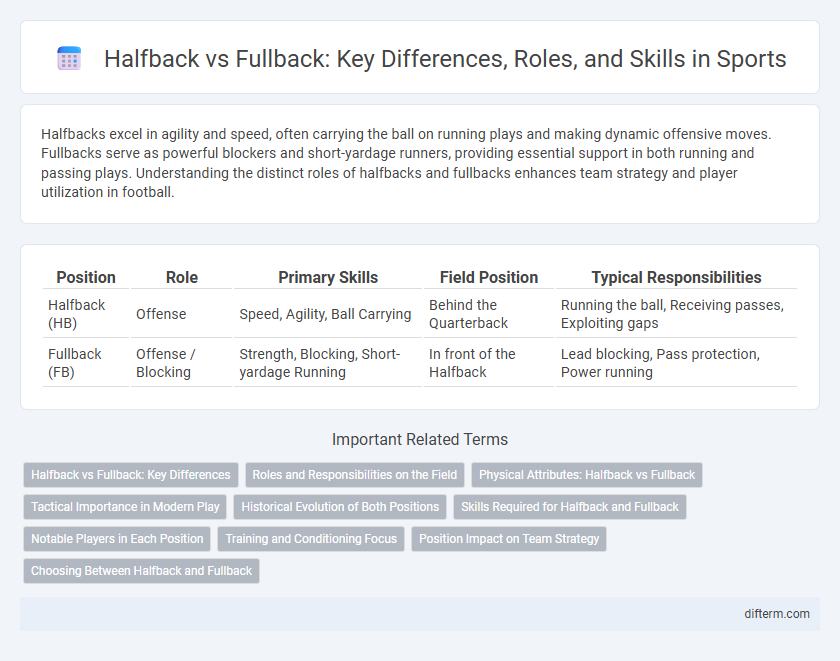Halfbacks excel in agility and speed, often carrying the ball on running plays and making dynamic offensive moves. Fullbacks serve as powerful blockers and short-yardage runners, providing essential support in both running and passing plays. Understanding the distinct roles of halfbacks and fullbacks enhances team strategy and player utilization in football.
Table of Comparison
| Position | Role | Primary Skills | Field Position | Typical Responsibilities |
|---|---|---|---|---|
| Halfback (HB) | Offense | Speed, Agility, Ball Carrying | Behind the Quarterback | Running the ball, Receiving passes, Exploiting gaps |
| Fullback (FB) | Offense / Blocking | Strength, Blocking, Short-yardage Running | In front of the Halfback | Lead blocking, Pass protection, Power running |
Halfback vs Fullback: Key Differences
Halfbacks excel in agility and speed, primarily responsible for rushing and receiving passes, making them crucial playmakers in offensive schemes. Fullbacks, characterized by strength and blocking ability, serve as lead blockers and short-yardage runners, providing protection for halfbacks and the quarterback. Understanding the distinct roles and physical attributes of halfbacks versus fullbacks highlights their complementary contributions to team dynamics and offensive strategy.
Roles and Responsibilities on the Field
Halfbacks primarily focus on rushing the ball, receiving passes, and executing quick plays to advance offensive yardage, often requiring agility and speed. Fullbacks serve as powerful blockers to protect the quarterback and clear paths for the halfback, while occasionally carrying the ball in short-yardage situations. Both positions demand versatility but differ in their core roles: halfbacks emphasize ball handling and evasion, whereas fullbacks prioritize blocking and physicality.
Physical Attributes: Halfback vs Fullback
Halfbacks are typically smaller, quicker, and more agile players, relying on speed and elusiveness to evade defenders and make significant yardage gains. Fullbacks possess a more robust, muscular build, which provides the strength necessary for powerful blocking, short-yardage rushing, and pass protection. This distinction in physical attributes underpins their specialized roles on the football field, with halfbacks emphasizing agility and open-field running, while fullbacks focus on strength and physicality in tight situations.
Tactical Importance in Modern Play
The halfback plays a critical tactical role in modern football by serving as a dynamic link between the offensive line and the skill positions, orchestrating plays and exploiting defensive gaps. Fullbacks contribute strategically through powerful blocking and short-yardage rushing, often creating running lanes and protecting the quarterback in high-pressure situations. Both positions require specialized skills that enhance offensive versatility and adaptability during complex game plans.
Historical Evolution of Both Positions
The halfback position originated in early football formations as a primary ball carrier, evolving from the rugby roots where agility and speed were paramount for advancing the ball. The fullback role developed later as a key defensive player responsible for fielding kicks and providing last-line defense, gradually incorporating blocking and occasional ball-carrying duties. Throughout the 20th century, strategic shifts in football tactics diversified both roles, with halfbacks becoming versatile offensive threats and fullbacks serving as hybrid players balancing protection and power running.
Skills Required for Halfback and Fullback
Halfbacks require exceptional agility, quick decision-making, and strong ball-handling skills to effectively navigate through defensive lines and execute precise runs or passes. Fullbacks need powerful blocking abilities, durability, and a keen understanding of offensive schemes to protect the quarterback and open running lanes. Both positions demand speed and spatial awareness, but halfbacks emphasize evasion and versatility while fullbacks prioritize strength and tactical positioning.
Notable Players in Each Position
Notable halfbacks like Walter Payton and Barry Sanders revolutionized offensive strategy with their agility and rushing prowess, becoming key figures in NFL history. Fullbacks such as Jim Brown and Mike Alstott gained recognition for their powerful blocking and short-yardage running, significantly contributing to team success. Each position boasts legendary athletes whose unique skills shaped the game's evolution on both rushing and blocking fronts.
Training and Conditioning Focus
Halfbacks prioritize agility, speed, and explosive power in their training to enhance quick direction changes and acceleration on the field, emphasizing sprint drills and plyometric exercises. Fullbacks focus on building strength, endurance, and blocking techniques through weightlifting, resistance training, and sustained cardio workouts to maintain durability in physical confrontations. Conditioning programs for halfbacks include interval training for short bursts, while fullbacks incorporate longer, steady-state conditioning to support sustained physical engagement.
Position Impact on Team Strategy
The halfback primarily influences offensive strategy through rushing and receiving, providing versatility in both ground attacks and pass plays. Fullbacks serve as key blockers, creating protective lanes and enhancing the effectiveness of running backs by absorbing defensive pressure. Their distinct roles shape team formations and play-calling, directly impacting overall game tempo and tactical execution.
Choosing Between Halfback and Fullback
Choosing between a halfback and a fullback depends on the offensive strategy and team formation. Halfbacks, typically faster and more agile, excel at rushing and receiving, making them ideal for versatile playmakers in spread offenses. Fullbacks, known for their strength and blocking ability, are preferable in power-running schemes where protection and short-yardage gains are essential.
halfback vs fullback Infographic

 difterm.com
difterm.com